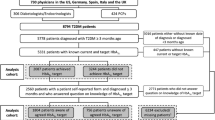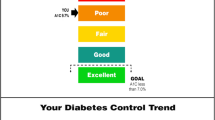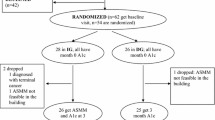Abstract
OBJECTIVE: To develop and test an inexpensive visual tool to help patients with diabetes improve glycemic control.
METHODS: A multidisciplinary team developed a 1-page form, the “Take-home Diabetes Record” (THDR), providing feedback to patients by displaying percent glycosylated hemoglobin (GHb) values graphically over time, with target levels highlighted. Patients with type 2 diabetes in an inner-city clinic were randomized to THDR use (n=57) or not (n=70) over 15 months. Self-care activities were discussed, linked with GHb results, and charted at each clinic visit. Initial and final GHb were compared.
RESULTS: Mean GHb fell significantly in THDR patients (−0.94, P=.003), but not in control patients (−0.18, P=.36). Mean GHb decrease was greater in THDR patients (P=.047). A greater proportion of THDR patients (51%) than control patients (18%) achieved a decrease in GHb ≥0.9 (P=.001).
CONCLUSIONS: A graph linking GHb and self-care activities shows promise for improving glycemic control.
Similar content being viewed by others
References
Chaturedi N, Jarrett J, Shipley MJ, Fuller JH. Socioeconomic gradient in morbidity and mortality in people with diabetes. BMJ. 1998;316:100–5.
Nordberg BJ, Barlow MS, Chalev SA, McCarter RJ. Effect of third party reimbursement on use of services and indexes of management among indigent diabetic patients. Diabetes Care. 1993;16:1076–80.
Steinman MA, Sands LP, Covinsky KE. Self-restriction of medications due to cost in seniors without prescription coverage. J Gen Intern Med. 2001;16:793–9.
Smith CM, Yawn BP. Factors associated with appointment keeping in a family practice residency clinic. J Fam Pract. 1994;38:25–9.
Adair RF, Nwaneri MO, Barnes N. Health care access for Somali refugees: views of patients, doctors, nurses. Am J Health Behav. 1999;23:286–92.
Jackson DA, Manning WG, Wells KB. Impact of prior and current alcohol use on services by patients with depression and chronic medical illnesses. Health Serv Res. 1995;30:687–705.
Harvey CA, Pantelis C, Taylor J, et al. The Camden schizophrenia surveys. II. High prevalence of schizophrenia in an inner city London borough and its relationship to socio-demographic factors. Br J Psychiatry. 1996;168:418–26.
Lustman PJ, Freedland KE, Griffith LS, Clouse RE. Fluoxetine for depression in diabetes. Diabetes Care. 2000;23:618–23.
Jones TF, Culpepper L, Shea C. Analysis of the cost of training residents in a community health center. Acad Med. 1995;70:523–31.
Sachs S. From a babel of tongues, a neighborhood. New York Times. Dec 26, 1999:Y1.
Kefalides PT. Illiteracy: the silent barrier to health care. Ann Intern Med. 1999;130:333–6.
Nuss JR, el-Kebbi IM, Gallina DL, et al. Diabetes in urban African-Americans: functional illiteracy of municipal hospital outpatients with diabetes. Diabetes Educ. 1997;23:563–8.
Ohmans P, Garrett C, Treichel C. Cultural barriers to health care for refugees and immigrants. Minn Med. 1996;79:26–30.
Heisler M, Bouknight RR, Hayward RA, Smith DM, Kerr EA. The relative importance of physician communication, participatory decision making, and patient understanding in diabetes self-management. J Gen Intern Med. 2000;17:243–52.
Cagliero E, Levina EV, Nathan DM. Immediate feedback of HbA1c levels improves glycemic control in type 1 and insulin-treated type 2 diabetic patients. Diabetes Care. 1999;22:1785–9.
Jacobs EA, Lauderdale DS, Meltzer D, Shorey JM, Levinson W, Thisted RA. Impact of interpreter services on delivery of health care to limited-English-proficient patients. J Gen Intern Med. 2001;16:468–74.
Hurwitz B, Goodman C, Yudkin J. Prompting the clinical care of non-insulin dependent (type II) diabetic patients in an inner city area: one model of community care. BMJ. 1993;306:624–30.
Aubert RE, Herman WH, Waters J, et al. Nurse case management to improve glycemic control in diabetic patients in a health maintenance organization: a randomized, controlled trial. Ann Intern Med. 1998;129:605–12.
Marrero DG, Peyrot M, Garfield S. Promoting behavioral science research in diabetes. Diabetes Care. 2001;24:1–2.
Nagafuchi S, Anzai K, Akazawa K, et al. The impact of a color-classified HbA1c graph for self-monitoring and self-adjustment of long-term glycemic control. Diabetes Care. 1993;16:1408–9.
Armstrong K, Fitzgerald G, Schwartz JS, Ubel PA. Using survival curve comparisons to inform patient decision making: can a practice exercise improve understanding? J Gen Intern Med. 2001;16:482–5.
Murphy PW, Chasson AL, Walker L, et al. Comparing the effectiveness of video and written material for improving knowledge among sleep disorders clinic patients with limited literacy skills. South Med J. 2000;93:297–304.
Vailas LI, Blankenhorn DH, Johnson RI, Selzer RH. A computerized quantitative food frequency analysis for the clinic setting: use in documentation and counseling. J Am Diet Assoc. 1987;87:1539–43.
Halwachs-Baumann G, Katzensteiner S, Schnedl W, Purstner P, Pieber T, Wilders-Truschnig M. Comparative evaluation of three assay systems for automated determination of hemoglobin A1c. Clin Chem. 1997;43:511–7.
Glantz SA. Primer of Biostatistics. New York: McGraw-Hill; 1992.
UK Prospective Diabetes Study Group. Intensive blood-glucose control with sulfonylureas or insulin compared with conventional treatment and risk of complications in patients with type 2 diabetes (UKPDS 33). Lancet. 1998;352:837–53.
Glasgow RE, Hiss RG, Anderson RM, et al. Report of the health care delivery work group: behavioral research related to the establishment of a chronic disease model for diabetes care. Diabetes Care. 2001;24:124–30.
Fisher L, Chesla CA, Skaff MM, et al. The family and disease management in Hispanic and European-American patients with type 2 diabetes. Diabetes Care. 2000;23:267–72.
Lutfey KE, Wishner WJ. Beyond “compliance” is “adherence.” Improving the prospect of diabetes care. Diabetes Care. 1999;22:635–9.
Author information
Authors and Affiliations
Corresponding author
Additional information
Received from the Department of Medical Education, Abbott Northwestern Hospital, Minneapolis, Minn.
Rights and permissions
About this article
Cite this article
Chapin, R.B., Williams, D.C. & Adair, R.F. Diabetes control improved when inner-city patients received graphic feedback about glycosylated hemoglobin levels. J GEN INTERN MED 18, 120–124 (2003). https://doi.org/10.1046/j.1525-1497.2003.20367.x
Issue Date:
DOI: https://doi.org/10.1046/j.1525-1497.2003.20367.x




